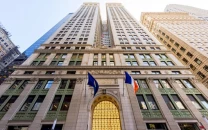SBP jacks up key interest rate by 100 basis points
Central bank revises up inflation forecast to 11-12% for ongoing fiscal year

Increase was in line with market expectations. PHOTO: FILE
The inflation is expected to accelerate due to recent rupee depreciation against the US dollar and the hike in gas price. Moreover, a possible increase in electricity tariff next month and the impact of measures taken in the budget FY20 to boost tax collection could also fuel inflationary pressure in the short-to-medium run.
"The inflationary pressure is expected to recede in second half of the fiscal year," SBP Governor Reza Baqir said at a news-conference on Tuesday. He gave an impression that the worst in the economy would be over in the first half and that it would gear up to return to the good days from the second half (January-June 2020).
The projected the economic growth rate at is slightly higher than the nine-year low of 3.3% recorded in the preceding fiscal year 2018-19. "SBP expect the real GDP (gross domestic product) growth of around 3.5% in FY20," he said.
He said that bulk of the needed adjustments in rupee-dollar exchange rate and key interest rate are seemed done. However, emergence of unforeseen factors in the future may make the central bank to adjust its fiscal and monetary policies, accordingly.
"The bulk of the needed adjustment in the real effective exchange rate to address the past overhang of overvaluation has been completed with the recent deprecation of the exchange rate," Baqir said. "While the exchange rate is flexible and market determined the SBP stands ready to take action to address disorderly market conditions in the foreign exchange market."
Moreover, with the decision of 100 basis points hike in key interest rates, the monetary policy committee (MPC) was of the view that "the adjustment related to interest rates and the exchange rate from previously accumulated imbalances has taken place," he said. "The real interest rates…are at appropriate levels, considering the cyclical weakening of aggregate demand," he said.
Going forward, the MPC will be ready to take action depending on economic developments and data outturns. Unanticipated increases in inflation that adversely affect the inflation outlook may lead to further modest tightening.
"On the other hand, a greater than expected softening in domestic demand and downward revision in projected inflation would provide grounds for easing monetary conditions," the SBP governor said.
The central bank has increased the key interest rate by 7.5% since January 2018. Baqir said that the rate hike will benefit people, who have parked savings in saving accounts at banks and/or in national savings schemes. "The interest rate hike will help control dollarisation in the economy. People will prefer to keep savings in rupee rather than in dollars."
Baqir maintained that the monetary policy committee expects average inflation at 11–12% in FY20 – higher than the previous projection. "Nevertheless, inflation is expected to fall considerably in FY21 as the one-off effect of some of the causes of the recent rise in inflation diminishes," he said. "The government has also committed to cease borrowing from the State Bank that would qualitatively improve the inflation outlook," he said.
Elaborating the expected improvement in economic growth in FY20, Baqir said the growth is expected to turnaround in the course of the year on the back of improved market sentiments in the context of International Monetary Fund's (IMF) supported loan programme worth $6 billion, a rebound in the agriculture sector and the gradual impact of government incentives for export-oriented industries.
Current account deficit reined
External conditions show continued steady improvement with a sizeable reduction in the current account deficit which fell by 29.3% to $12.7 billion in Jul-May FY19 as compared to $17.9 billion during the same period last year.
This improvement was primarily driven by import compression and healthy growth in workers' remittances. Export volumes have been growing even though export values have remained subdued due to a fall in the unit prices as also experienced by competitor exporting countries.
"Future developments in export performance will also depend on growth rates of our trading partners and progress in alleviating domestic structural impediments," Baqir said.
However, the outlook for external financing has further strengthened with the disbursement of the first tranche associated with the IMF Extended Fund Facility, activation of the Saudi oil facility, and other commitments of support from multilateral and bilateral partners.
Moreover, "the sentiment towards emerging markets has improved with greater expectations of a policy rate cut in the United States," he said.



















COMMENTS
Comments are moderated and generally will be posted if they are on-topic and not abusive.
For more information, please see our Comments FAQ